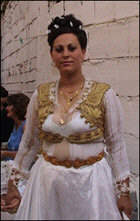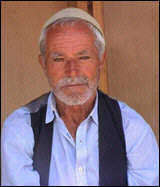 CULTURE CULTURE |
 KOSOVAR FOOD & CULTURE KOSOVAR FOOD & CULTURE |

Fruits and vegetables at Prishtina´s flea market
Albanian's are known to have very old traditions and are people of enormous goodwill and strong family morals. In Kosovo it is customary to take off your shoes upon entering an Albanian house particularly if it is Muslim. As a foreigner and visitor to the country you are always made to feel extremely welcome. Local food is more "Mediterranean" than "Albanian" food as root vegetables are more commonly used when preparing most traditional dishes such as Kaçamak (Potato omelette) and Flia (a local dish that resembles a salty pancake which is eaten with cheese and yoghurt.)
Pite is also a local popular dish that shares many similarities to a large pastry that can be filled with spinach, meat or white cheese. Montia is also a very similar dish to Pite but is only filled with meat and is served as a small square pastry.
Kosovar Albanians are very social people and enjoy their much-loved local beverages at social occasions such as Kosovar Raki or their locally produced wines Kosovo Merlot and Cabernet Sauvignon. Kosovo Riesling is also recommended should you prefer a lighter white option. Another popular drink is the locally produced lager from the beautiful mountainous region of Peja, which is similar in taste to Pilsner and well known throughout the region. Should you prefer something a little more cosmopolitan and less alcoholic, the cities and towns of Kosovo are literally brimming with coffee and teahouses.

Sunday drinking coffee
The art of coffee drinking, particularly in the afternoon is a favourite pastime in Kosovo and you don't have to walk very far until you find a place to rest your feet. The Kosovar Albanians simply have to be one of the greatest coffee loving nations within Europe.
 TRADITIONAL COSTUME & MUSIC TRADITIONAL COSTUME & MUSIC |

Traditional Kosovar Bride | Traditional Albanian dress is very similar throughout the region with only a few minor differences that can be seen in Kosovo and other surrounding countries. At cultural functions the men and women are usually dressed in white clothing decorated with a combination of red and black and occasionally green garments, such as aprons, headscarves and waste jackets that adorn the entire costume. It is very traditional for the women to wear lots of gold, to demonstrate the wealth of her husband. The clothes worn at these occasions are always handmade by the female community.
The day preceding a Kosovar wedding the women traditionally dress entirely in white and wear a gold jacket called a jalek i art, This jacket is worn with dimia which are extremely baggy trousers that resemble a skirt. The wedding costume for a woman is habitually accompanied by a lot of gold.

Old Albanian man with Plis
A very common sight that can be seen amongst the older generation in Kosovo is the Plis. This is the traditional white bowl hat worn to signify their culture and Albanian heritage. The Plis varies in shape and size according to which region in Kosovo the person comes from and can either be flat on top or rounded according to the traditions of the province.
At most festive celebrations locals play an instrument called the Citelia, which is very similar to a small guitar but has only two strings. The Tupan usually accompanies the Citelia, and is a traditional Albanian drum. A common feature of most Kosovar Albanian celebrations is the creation of a room called the Oda, which is a room specifically for men where they sing songs usually, based on historic events and stories talk, smoke and celebrate by drinking Kosovar Raki. Traditionally the women during these moments usually prepare food and attend to the male guests.
Circumcision is also a very common practice in Kosovo as in all Muslim countries, it is often performed as celebratory ritual to mark the beginning of male puberty. The ritual is accompanied by festive celebrations and large family gatherings. |

